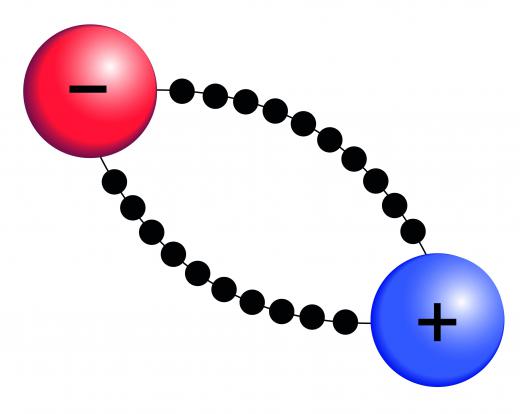What Is Air Ionization?
Ionization is the process whereby atoms and molecules become electrically charged, forming ions. An atom can gain one or more electrons to form a negative ion or lose electrons to form a positive ion. Air ionization refers to the ionization of air molecules. This can take place as a result of various natural processes, or a device can be employed to ionize the air in order to bring health benefits either directly or through air purification by the removal of airborne allergens, pathogens and pollutants. It generally is agreed that negative ions are more effective than positive ions for these purposes.
Air ionizers generally work by applying a high-voltage electric current to a metal prong or needle. An electric current consists of a flow of negatively charged electrons. As the electrons approach the end of the needle, the electrostatic repulsion between them causes them to detach from the metal surface and attach themselves to molecules of nitrogen and oxygen in the air and to airborne particles, forming negative ions.

Although the claimed direct health benefits of negative ions, such as relief from seasonal affective disorder (SAD) and depression, are the subject of research and debate, there is good evidence from a number of studies that ionization, particularly with negative ions, can purify the air by removing small suspended particles that might harbor harmful bacteria or allergens. It seems that when these particles become ionized, they tend to settle onto grounded surfaces, such as walls and floors, leaving the air cleaner. Air ionization has been used successfully in the dusty atmosphere of poultry farms, for example, to remove harmful bacteria from the air and to reduce the incidence of disease.

Another useful application for air ionizers is in the prevention of electrostatic discharge. For example, an electrical charge can build up on sensitive electronic parts during handling or assembly, resulting in sparks that cause damage. An air ionizer can help neutralize charges before discharge takes place.
The effects of air ionizers might not always be beneficial. The ionization of nitrogen and oxygen can result in the formation of small amounts of ozone and nitrogen oxides. These are lung irritants and are classed as pollutants. There is concern that some air ionizers could generate harmful levels of these gases.

Air ionization can also take place naturally, such as during thunderstorms and by the action of sunlight. Rock that is subjected to pressure can generate electric currents that might manifest themselves as air ionization around surface rocks. It has been suggested that earthquakes could be predicted by the detection of ionization effects in earthquake zones.
AS FEATURED ON:
AS FEATURED ON:















Discussion Comments
I had a quick look at a couple of ads and reviews for this product. As you say, the effect, if genuine, may have to do with static electricity. I can't think of any other explanation.
Friction between two different, non-conducting materials can lead to electrons moving from one to the other, building up a negative charge. This is how a Van de Graaff generator works - the top is nearly spherical to prevent electrons leaking away from any points or sharp edges, which would cause air ionization. In the case of bamboo microfibers, perhaps movements during sleep - or whatever you happen to be doing in bed - cause a build up of electrons in the microfibers, so that the electrons leak away from the tips, resulting in the formation of negative ions in the air. This is just a guess.
As for the supposed benefits, negative ions can help remove potentially harmful particles from the air - bacteria, dust, allergens etc. The product description mentions research at the University of Berkeley, California to do with the effects of negative ions on serotonin levels in the brain. Seasonal affective disorder and depression have been linked to low serotonin levels, but I would seek independent confirmation of the effects of negative ions on serotonin levels before spending any money!
As for the glow effect, there was no mention of it in any of the material I read. I doubt that static electricity would do this in a bed sheet,and in any case I'm not sure why you would want your sheets to glow in the dark - surely you wouldn't get much sleep?
I was just looking at an ad for Bamboo bed sheets "Now you can enjoy luxury of IONZ bamboo microfiber bedding with negative ion technology for better sleep. The patented bamboo fibers used in the sheet production have been scientifically proven to produce 1,500 CC's of Negative Ions and above. This Negative Ion output is higher than most ultra expensive air Ionizers."
I'm very curious, and a little skeptical!
There's deal on these that brings the cost into a range I'd consider spending on sheets.
The 'lighting up' could be static electricity(?)
Without knowing more about your air ionizer, it's difficult to say how it works. I don't think the lighting up effect is directly connected to air ionization; presumably it has a small battery and some kind of touch sensitive surface that completes a circuit to power some LEDs.
Air ionizers produce very small quantities of ozone and nitrogen oxides; these gases can cause health problems if the concentration is high enough. The occupational exposure limits - for long-term exposure - are 0.1 parts per million (ppm) for ozone and around 3ppm for nitrogen dioxide in the USA, UK and most of Europe. If your ionizer produces concentrations of these gases in excess of these limits there may be cause for concern, but only if you have it switched on regularly for long periods. Determining the amounts of ozone and nitrogen dioxide produced would require testing in a laboratory. I'm not sure where you would take it; it would depend on where you live. Alternatively, you could check if it complies with the appropriate standards for your country.
I have a bamboo sheet that has negative ions. It lights up when I touch the sheet. How is this done and is it dangerous?
Post your comments